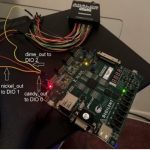The goal of this paper is to describe the motivation, methodology and results of introducing Active Learning Techniques in a Digital Design course. Digital Design is a four-credit junior level course for electrical and computer-engineering technology majors at Farmingdale State College, State University of New York. The students enrolled in this course have a large range of skills in term of experience with laboratory equipment, computer-based tools, and programming. The course introduces students to VHDL Hardware Description Language as the design entry method for digital circuits and to Field Programmable Gate Arrays (FPGA) platforms for the implementation of the digital circuits. Active learning techniques implemented in the course offer students more learning opportunities, potentially improving students’ knowledge and skills in digital design.
Archives for 2021
Simulation-Based Reflection in a Digital Circuits Course
A unique method for promoting reflection among engineering students was used in the present study involving a digital circuits course. The method combined computer-based simulation for digital circuit design with reflective-thought prompts after a midterm exam for post-exam analysis and reflection. This method was first implemented in a microelectronics course using the SPICE simulator, and lessons learned from the initial implementation were applied to the digital circuits course. These lessons learned included the need to scaffold students in the use of the simulation tool for reflection, the need to balance frequency of reflection with student workload and fatigue, and the need for question prompts that voluntarily elicit broad thought after a milestone event such as a midterm exam (versus a quiz). Using a published depth rubric, the assessment results found increased depth of reflection in the present course relative to the initial implementation in microelectronics. Specifically, there were increases in depth of reflection after the midterm exam in the present course versus the midterm exam and two quizzes in the microelectronics course, and the increases in depth were significant relative to the quizzes. There was also an increase in the relative occurrence of broad reflections in the present course, with significant differences compared to the quizzes. Although significant differences were not found in the final exam averages based on depth of reflection after the midterm exam or participation in this reflection, results from a follow-up survey several months after the course ended indicated benefit for students. Specifically, 80% of those who competed the reflection exercise indicated a high or very high perceived benefit from doing so. Of the approximately 50% who chose not to complete the reflection exercise, the primary reasons were identified via the follow-up survey. Findings from this work align with and add to the developing literature on student reactions to reflection.
Use of Open-source Software in Mechatronics and Robotics Engineering Education – Part I: Model Simulation and Analysis
Open-source Software (OSS) provide attractive solutions for complementing Mechatronics and Robotics Engineering (MRE) education due to their numerous advantages such as free access, customizability and wide community support, increased adoption and utilization in industry, etc. To provide a deeper insight on the current status, limitations, and potentials of the OSS, a summary of the results of an online survey, conducted among various community stakeholders, is included. Furthermore, the two parts of this contribution are intended to provide an exposure to the OSS which have the potential to be used in MRE education. To this end, two specific problems, namely, model simulation and analysis of a DC motor (Part I) and controller implementation for a 2-DOF robot manipulator (Part II), are solved using Python, Java, Modelica, GNU Octave, and Gazebo. The systems chosen for this work are some of the most-commonly encountered systems and the considered problems, i.e. model simulation, analysis, and control implementation, are fundamental problems in the context of MRE. Therefore, this work can help MRE instructors familiar with these OSS to easily integrate them into their respective courses. On the other hand, the students can also greatly benefit from this work as it provides an entry point into applying different OSS in MRE-related courses and projects. Exposure to various ways in which an MRE problem is translated into a software solution enables the students to generalize their problem-solving process across different computational tools. Students equipped with such a skillset would potentially have a flexible mindset and could make well-balanced and informed judgements when devising a solution to a real-world engineering problem. Full code scripts for each of the OSS introduced in this work, along with Matlab which is intended as a point of comparison, are included on the GitHub repository of the paper to provide free access to the community and to help with widespread adoption of the OSS in MRE higher education.
Using MULTISIM software as a replacement or supplement for physical labs
The article presented here demonstrates using MULTISIM as an educational tool to enhance student learning process by discussing the use of MULTISIM for teaching basic electrical circuits consisting of analysis of Series-Parallel Circuits, Superposition Theory, Thevenin Theory and Norton Theory. The article presented here discusses using the software as an aid to check the intermediate steps of hand calculation techniques that must be used if no computer software were being used.
Learning Analytics of Outcomes-Based Engineering Programs’ Data
In the recent years, learning analytics is attracting attention in tertiary education sector. This paper presents a case study of applying learning analytics approaches to discover knowledge from Outcome Based (OB) engineering programs’ data. More specifically, Association Rule Mining approach is applied to a dataset extracted from the Self-Study Reports of 152 engineering programs accredited by American Board of Engineering and Technology (ABET)




